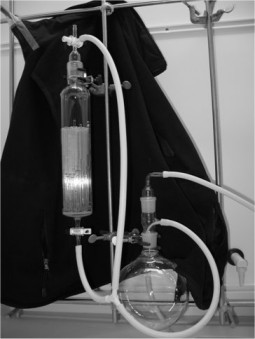A Simple Device for Cleaning Many NMR Tubes Simultaneously
The elongated cylindrical form of the classical nmr tube makes them difficult to clean for reuse, especially if hundreds of tubes are to be washed. Existing techniques include washing every single tube manually or using some commercial (or home-made) tube cleaners that can wash up to five tubes at the same time. Soaking baths where the tubes are immersed in solvents is another technique. Applying these methods to hundreds of tubes is boring, time-consuming, and may expose the user to organic solvents. Because of these inconveniences, the wasteful use of disposable tubes is common. In this short communication is described a simple device that can clean and dry more than hundred tubes at the same time with very little user effort. Its spectacular mode of action amuses its user and the tube cleaner is easily assembled using equipment normally present in the organic chemistry lab. The tube cleaner has a closed construction that minimizes exposure to organic solvents, and the cleaning result is fully acceptable for most purposes in nmr spectroscopy. The cleaner and its construction are primarily intended for those that wash many hundred nmr tubes every year. If only a few tubes are to be cleaned, or if it is very important that the tube is perfectly clean, use of a single tube cleaner is probably more effective.
The crucial parts of the cleaner are a thick-walled flash chromatography column with an outlet stopcock, a three-way stopcock and a collecting flask connected to a vacuum line. Butyl rubber tubing (6x12 mm, suitable for vacuum applications) is used to connect these parts together via a tubing connector. PVC tubing should be avoided as it contains additives that become soluble in organic solvents. I use the central vacuum (5-10 mbar) available in my fume hood but vacuum generated by other methods will work as well. Figure 1 shows the washing of 100 tubes. In principle the technique consists of filling the flash chromatography column with nmr tubes standing upside down, closing the outlet stopcock, then the three-way stopcock is lifted and solvent that covers approximately 2/3 of the height of the tubes is introduced into the column (Warning! Do not fill more solvent than 2/3 of the height of the tubes, the tubes must not float!). The column is then evacuated using the three-way stopcock (which is placed at the top of the column and connected to the vacuum line). After evacuating, the three-way stopcock is opened so that air of atmospheric pressure enters the column. The result is that the tubes are filled with solvent! Again the three-way stopcock is used to evacuate the column which results in solvent being sucked out from the tubes! Repeating this procedure dissolves adhered material present in the tubes. The spent solvent is then discharged by opening the outlet stopcock of the column and collected in a 2 liter spherical flask. The outlet stopcock is closed again, air is introduced by using the three-way stopcock, and new solvent is introduced into the column. Again the procedure for filling and emptying the tubes with solvent is repeated, and when the tubes are clean they are dried in the column by standing in vacuum for a while.
parsetable('98%', '', '[tr][td][url=255]

[/url][/td][td]

[/td][/tr][tr][td]
Figure 1. Washing 100 tubes.[/td][td]
Figure 2. The cleaner without column or collecting flask.[/td][/tr]')
Some important notes:
- The performance of the cleaner increases if a bigger hole is drilled in the Teflon cock of the three-way stopcock. A bigger hole results in faster inlet of air and faster uprising of solvent in the tubes.
- The collecting flask for spent solvent should be at a lower level than the column in order to facilitate emptying the column.
- If the unwashed tubes contain solid residues the tubes are filled with solvent and the column is left in a horizontal position, preferable overnight.
- Normally, consecutive washings with tetrahydrofuran 2 times, methanol 1 time, and acetone 2 times will leave the tubes sufficiently clean for renewed use. Use of more viscous solvents, e.g. water or DMSO, is possible but emptying the tubes becomes more difficult.
- Improvement of the equipment is possible by help of a glass craftsman and include:
(a) the column may be divided into two parts with flat flanges held together with clips and filling and removal of tubes becomes easier,
(b) the fritted glass filter in the column can be replaced by a perforated filter enabling smaller particles (from printed marks on the tubes etc.) to escape together with the spent solvent. Printed marks on the tubes (catalog numbers etc.) are a problem because these marks are insoluble and tend to adhere to other parts of the tube during the washing procedure. They can be removed by treating the unused tubes with 65% nitric acid in a beaker before washing, or better, use tubes with etched marks instead,
(c) large vacuum chambers where plastic racks containing many hundreds of tubes are placed upside down are conceivable and constructible. - Operating the device becomes obvious upon practical use. WARNING!! It is recommended that the usual precautions (goggles, safety screen, fume hood, etc.) are taken when working with solvents and glassware under vacuum. Wrapping the equipment in a net or similar is advisable especially if large columns are used. Make sure that if a flash chromatography column is used it was designed to withstand an overpressure. This will give additional security when used in vacuum.

